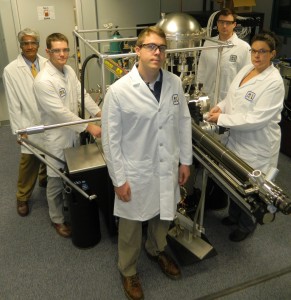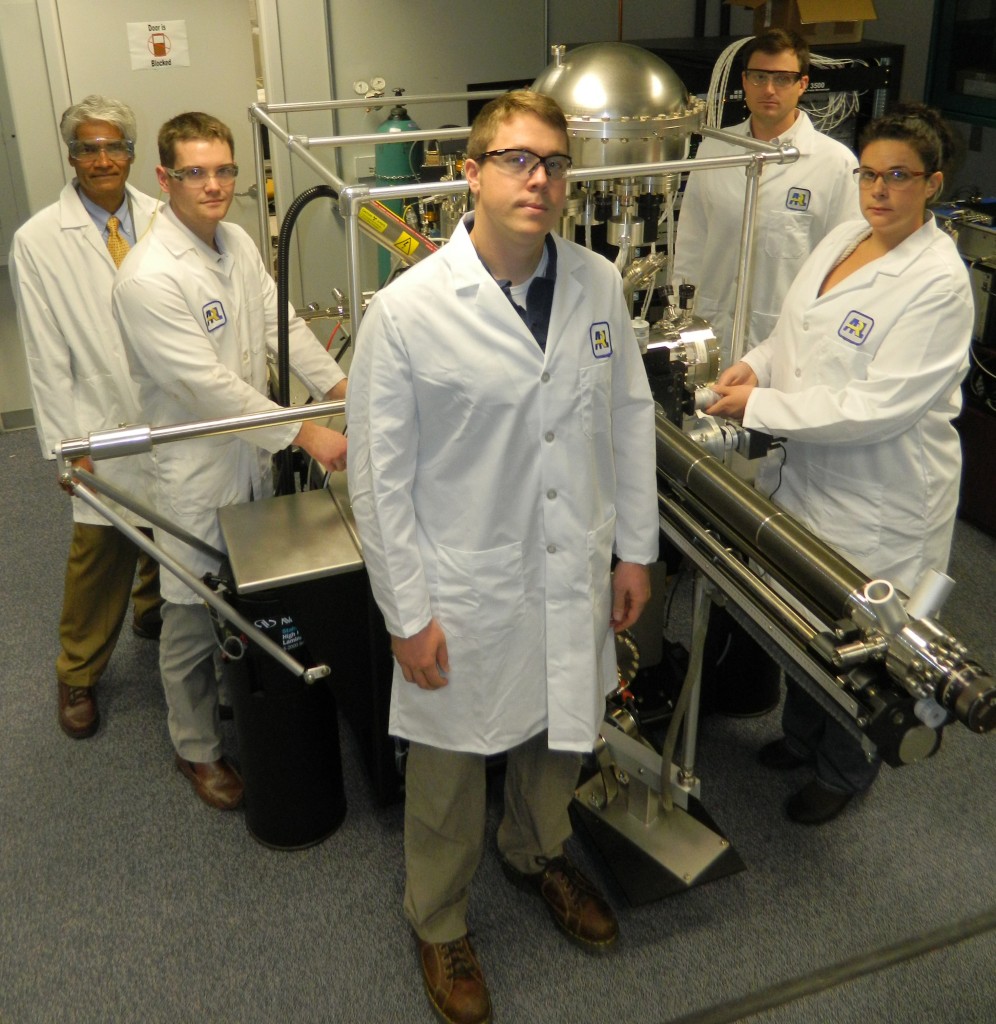
ADELPHI, Md. – Army researchers are building a portable drug detector that, soon, could help military and civil law enforcement agencies throughout the country more quickly catch synthetic drug abuse.
The U.S. Army Research Laboratory’s prototype biosensor model is expected to directly detect the active chemical substitutes that help “fake pot” fade from notice in commercially available synthetic cannabinoid detectors. It would be the first field-ready test on the market.
In 2012, the Army Criminal Investigation Command, known as CID, conducted 1,675 investigations involving soldiers and spice, bath salts, or other synthetic drugs, according to a May 2013 Army Times article.
Army Research Laboratory, or ARL is collaborating with the U.S. Army Criminal Investigation Laboratory, or ACIL, on this work, as synthetic cannabinoids are a rising threat that burdens their case-load. Currently there are no fieldable detection systems to perform analysis on the spot and tests are sent back to ACIL for evaluation. ARL is attempting to build a sensor that is not only portable, but can detect an ever-changing culprit.
“Garage chemists” sneak their concoctions of chemically laced kitchen herbs past detectors law enforcement use today, because those biosensors are designed to find a specific molecule. “But there are hundreds of synthetic cannabinoid variants, so a sensor that detects one specific synthetic cannabinoid that is seen on Spice or K2 would be quickly outdated as these types change regularly,” said Dr. Mark Griep, principal scientist on the project, who works in the Composite and Hybrid Materials Branch in ARL’s Weapons and Materials Research Directorate.
Griep joined with Dr. Shashi Karna, an Army senior research scientist and noted international expert in nanotechnology, to form a team of government and academic scientific investigators in building a detector that “will be able to detect the whole “class” of chemicals that have an affinity for the cannabinoid receptors in the brain,” Griep said. These are the receptors that are targeted by the drug and induce its effects. “Therefore, even if entirely new synthetic cannabinoid molecules are created, they are created to activate these receptors, so our sensor will be sensitive to them.”
This work builds upon the fundamental bio-nano science conducted at ARL and the Michigan Technological University in 2008, where a joint team of military and university researchers developed a unique opto-electronic hybrid system based on the integration of quantum dots with the highly functional protein bacteriorhodopsin, and revealed the fundamental science and mechanisms behind their interactions.
Based on this hybrid bio-nanomaterial, researchers were able to patent a system they developed that could selectively target a material, and when that target binds to the sensor it induces a change in the proteins electrical output.

With this understanding of the materials, ARL was able to develop a unique sensing platform that is amenable to functionalization toward a wide variety of airborne or liquid targets. The base platform is very generic and could be tailored it to a multitude of sensing needs, explained Griep.
“Although this bio-nano sensing platform wasn’t developed with drug sensing in mind, this program leverages our bio-nano sensor expertise towards a specific drug testing problem. The fact that our sensor platform has the potential to be small, lightweight, user-friendly, and fieldable in addition to being generic enough to be tailored towards synthetic cannabinoid detections made it a unique fit to fill this specific drug detection need,” Griep said.
Synthetic marijuana arose from the “unfortunate manipulation of science far outside the intended purpose” to study the effects of cannabinoids on brain functioning and their efficacy in treating pain, Griep said. Several cannabinoid compounds were created to help advance the treatment of serious ailments like multiple sclerosis, AIDS, and cancer.
The protocols of basic science to communicate findings in open literature, namely the “Materials and Methods” section, “became a shopping list and recipe for garage chemists with ambitions straight out of AMC TV’s Breaking Bad. They laced natural herbs with these molecules and advertised the product as a legal alternative to pot, with the further come-on that this substitute could not be detected in drug tests. At the same time, a warning label said the item was not for human consumption as a way to skirt watchdogs like the U.S. Food and Drug Administration,” said Griep, who first created new biosensor platforms for a DARPA-funded project in 2008.
He is tailoring bio-nanosensing platforms he created to build the synthetic cannabinoid detection platform. His research team at Michigan Technological University and ARL won the Paul A. Siple award for their efforts in Bio-Nanoelectronics at the Army Science Conference in 2010.
Griep said traditional drug-focused sensors are focused on two aspects. Finding the synthetic cannabinoids before use, which is what the ARL model is being designed to do, and detecting the drugs after use and after they have been processed in the body, which is when urine and hair analyses come into play.
“Although detecting the drug after it’s in the body is standard for normal marijuana and THC [tetrahydrocannabinol ] metabolites, it is hard to implement for synthetic cannabinoids since a lot of research is required to find out how each specific chemical is processed in the body. This is has been figured out for a few synthetic cannabinoids, but the problem comes back to the hundreds of variants of these synthetics. A new test would need to be developed for each variant,” Griep said.
There is plenty of research available that gives a sense for the complexity of the “system to process chemicals in your body. So even if there’s a single atom or bond change in the material, the entire pathway could change. Thus, the end product, or what ends up in your hair or urine, could be greatly different. Every synthetic cannabinoid has a different structure or functional group arrangement, so it will be processed differently in the body,” Griep explained.
The Department of the Army banned the use of synthetic marijuana for Soldiers in 2011. Earlier this month, the Department of Defense approved the addition of synthetic cannabinoids to the approved random testing panel within the next ninety days, said Buddy Horne, drug testing manager for the Army Substance Abuse Program.
Synthetic cannabinoids are substances chemically produced to mimic THC, the active ingredient in marijuana. When smoked or ingested, they can produce psychoactive effects similar to those of marijuana and have been reportedly linked to heart attacks, seizures and hallucinations. Some abusers reported marijuana-consistent effects such as sleepiness, relaxation and reduced blood pressure, but others have reported symptoms not common with marijuana abuse such as nausea, increased agitation, elevated blood pressure and racing heart rates.
The Michigan Technological University expects to deliver to the Army a unit to house ARL’s biosensor technology in December.
ARL expects to deliver a functional prototype to ACIL by the end of 2014, but until then, Army researchers will work with collaborators from the National Institutes of Health, ACIL and the DEA to test its efficacy using real-world synthetic cannabinoid samples.
If it works well, Griep said, this device could quickly roll out to military police and civilian law enforcement agencies around the country.
ACIL is responsible for all the forensic investigation work within the DOD. In the case of synthetic cannabinoids, whenever military police investigators come across a suspicious sample or there is a synthetic drug case involving military personnel during an investigation, the contents of the sample must be evaluated and proven at ACIL.
“Since there aren’t any field tests, all the characterization and analysis is done at ACIL. There are a tremendous amount of potential synthetic cannabinoid related cases, so there’s quite a workload of samples arriving at ACIL,” said Griep.
“If there was a good field-able sensor – our work’s goal – capable of allowing law enforcement to determine if the suspicious package contained synthetic cannabinoids or not, then the ACIL workload would be cut down since only samples that actually contain synthetic cannabinoids would be sent back for analysis.”









